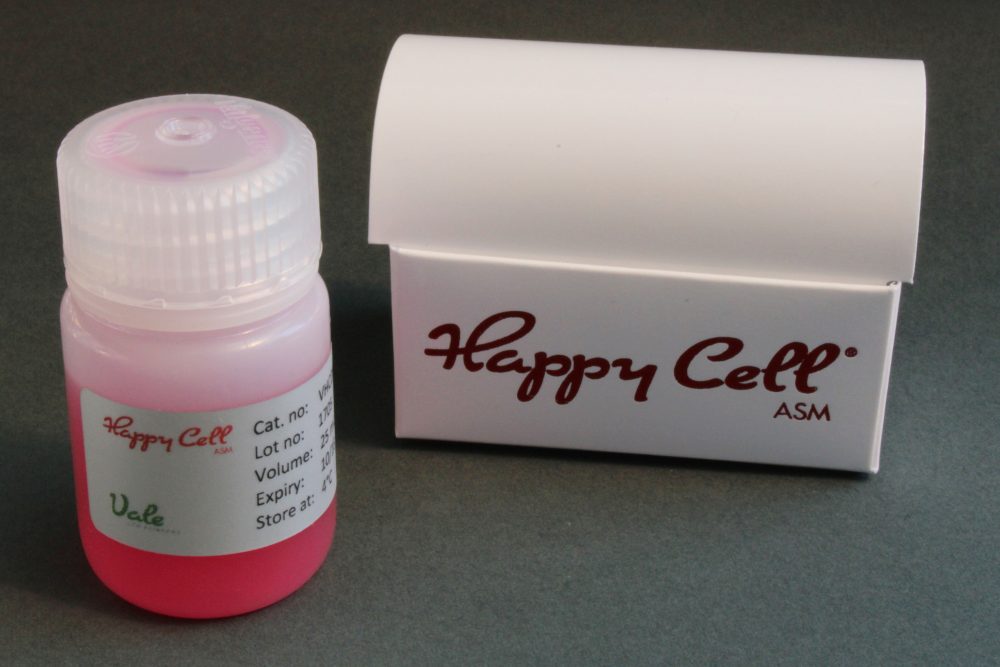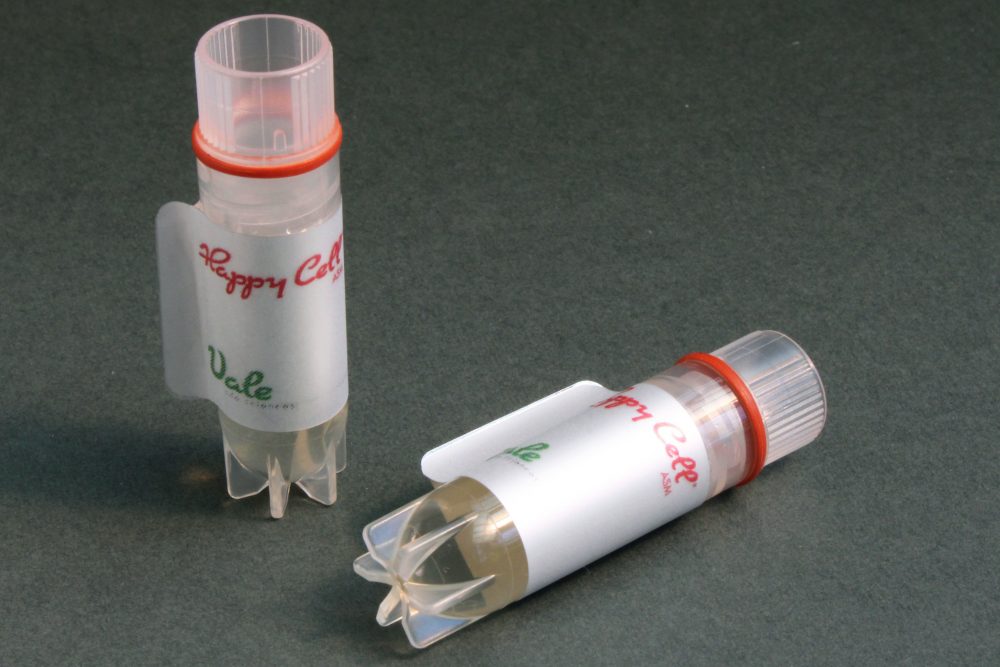Revolutionising Cell Culture in 3D – World’s First Liquid Scaffold for Cells


Happy Cell® ASM is a unique, low viscosity, low density, animal-free, cell culture reagent that permanently suspends cells.
Designed for drug discovery and biomedical research it allows easy labelling, washing and dosing of cells.
Used for:
Unique, low viscosity, liquid, animal-free, cell culture reagent that permanently suspends cells and allows for quick and easy sample recovery and analysis
Compatible for use with Cell lines, Stem Cells and Primary Cells
One 25ml bottle of Happy Cell® will give up to 1000 individual experiments
Widely used in the fields of cancer and stem-cell research
Optimises the formation of 3D cell structures such as spheroids and organoids
Facilitates the rapid expansion of single cells
Can be used interchangeably, or in conjunction with, all other classes of 3D cell culture technologies
Animal free
Consistent from batch to batch
Free of growth factors and cytokines
(If needed these can be added to meet your individual experimental requirements)
Tuneable
Ships at ambient temperature – No freezing or defrosting required
Compatible for both small size experiments and large size experiments: Happy Cell® allows you to use it to conduct very small scale or very large scale experiments. You can use microlitres or 1000’s of litres
Excellent optical properties – transparent to all wavelengths of visible light with the same refractive index as water. It has been developed for use with label free, fluorescence, luminescence and optical density.

Facilitates the recovery of 3D multi-cellular structures and dramatically improves the quality of your data.
It does this by irreversibly disrupting the Happy Cell® ASM suspension polymer complex. NB – It does this without compromising cellular integrity and function.
Animal free
Versatile & Easy to use
Consistent from batch to batch
Free of growth factors and cytokines
No freezing or defrosting required – ships at ambient temperature
Designed to be used with Happy Cell® ASM
Highlights:
“intestinal human organoids self-proliferate in suspension culture”. In this study the researchers “investigated suspension organoid culture without scaffolds for easier harvesting and assays. Their rationale was that: “These techniques enable us to develop, maintain, and expand intestinal organoids readily and quickly at low cost, facilitating high-throughput screening of pathogenic factors and candidate treatments for gastrointestinal diseases”.
Highlights:
In this study Happy Cell ASM® was used to improve the 3D ex-vivo expansion of patient derived CTC’s. It showed CTCs grown in 3D (Happy Cell ASM®) retained their proliferative capacity for several weeks post isolation 2D Vs 3D: Cells grown in 2D remained proliferative 35-50 Days compared to those grown in 3D (Happy Cell ASM®) which remained proliferative for approximately 2 weeks longer.
Highlights:
In this study, the authors reviewed ”several technologies currently available for producing in vitro 3D disease models. They assessed “the amenability of these technologies with high-content screening and HTS and highlight (their) own work in attempting to address many of the practical problems hampering the successful deployment of 3D cell systems in mainstream research”.
Highlights:
(The) “Very first use of living cells with label-free biolayer interferometry (BLI). The adherent human epidermoid carcinoma cell line A431 was suspended in 2× Happy Cell® Advanced Suspension Medium. The composition of Happy Cell® Advanced Suspension Medium is designed to keep cells floating in suspension. This property was exploited to facilitate the attachment of A431 cells directly onto the biosensors prior to analysis’.
Highlights:
Cancer Spheroids were successfully cultured Cells in Happy Cell ASM® in both normoxic and hypoxic conditions. A higher colony-forming ability trend was observed in cells grown under hypoxia in all NSCLC cell lines investigated.
Highlights:
This study optimised and validated Happy Cell ASM® to study the combined effects of cisplatin and DHMEQ in a 3D isogenic model of cisplatin-resistance in NSCLC using a variety of analytical techniques.
Highlights:
Cancer model (TSUPr1/B1/B2) and the non-muscle-invasive basal 5637 bladder cancer cell lines were grown in Happy Cell ASM to form three-dimensional spheroid cultures. Compared to their two-dimensional counterparts incrementally better responses were seen when using three dimensional cells. This study provides evidence that PAM (plasma activated medium) preferentially inhibits mesenchymally-shifted carcinoma cells, which have been associated with resistance to other therapies.
Highlights:
Long-term in vitro nanoparticle studies are hampered by a lack of suitable models as standard cell culture techniques present several drawbacks, while technical limitations render current three-dimensional (3D) cellular spheroid models less suited. By controlling the kinetic processes of cell assembly and division in Happy Cell® ASM the authors were able to engineer reproducible cell clusters of controlled size and phenotype, leading to a convenient and flexible long-term 3D culture that allowed nanoparticle studies over many weeks in an in vitro setting.
Happy Cell® ASM is a unique, low viscosity cell culture medium designed by a scientist for use by scientists. It meets all the requirements laboratories in the drug discovery world are demanding – that is, it is cost effective, scalable, rapidly deployable and simple to use as well as being compatible with automation with minimal human Intervention.
Happy Cell® features a unique modified natural inert polymer suspension system that can be de-activated allowing for analysis and recovery of cell and tissue samples.
It is supplied at and should be used at, ambient temperature.
Never freeze Happy Cell® ASM
Happy Cell® ASM is supplied as a 4X concentrate. Currently, it is only available as a 25 mL volume. This is sufficient for 1000 experiments using a 1X concentration in a 96 well plate.
Happy Cell® ASM should be stored at 2-8°C and never frozen. Under these conditions it is stable until the expiry date on the packaging. It can be shipped at ambient temperature.
Yes, Happy Cell® ASM contains Penicillin-Streptomycin (Gibco, Catalogue number 15140122) at a final concentration of 1%.
If you are interested in the possibility of obtaining Happy Cell® ASM without antibiotic please contact us to discuss. Simply email enquiries@valelifesciences.com with your question(s) and contact details and we will get back to you.
Happy Cell® ASM does not contain any growth factors. Additional supplements, such as growth factors and FBS, can be added by the end user at their desired concentration.
Happy Cell® ASM does not present an obstacle to most fluorescence-based assays.
It is normally supplied with Phenol red included in the media but can be formulated in Phenol Red-free media if desired and specifically requested.
Happy Cell ASM is supplied as a 4X concentrate and is readily diluted to the required working concentration with standard cell culture medium and desired additives.
A 1X concentration is appropriate for most applications, however, depending on the cell line in question, spheroids will grow at different rates and to different sizes and densities. Therefore, a higher concentration of Happy Cell ASM may be required to support larger spheroids and maintain cellular suspension.
Happy Cell® ASM can be dispensed at any temperature above 4° C. However, for ease, we recommend warming Happy Cell® ASM to room temperature (18 – 22° C) prior to dispensing.
Cells can be cultured indefinitely in Happy Cell® ASM once they are appropriately maintained.
Cells in Happy Cell ASM do not require agitation in order to form 3D structures. If culturing in 50 mL bioreactors, however, we do recommend inverting the bioreactor gently twice post cell feeding. This is to allow the fresh Happy Cell ASM to mix with that already in the bioreactor and to facilitate the even distribution of essential nutrients to all cells.
The duration of time taken to observe spheroid formation in Happy Cell® ASM and for spheroids to reach a certain size varies between cell lines.
Typically, 3D structures will begin to form within 24 hours of seeding.
We recommended regular sampling and microscopic observation of cultures to monitor spheroid growth.
Spheroids are easily harvested from Happy Cell® ASM using the inactivation solution.
See the product information guide for suggested protocol.
Spheroid disassembly or disaggregation, can be achieved either by treating the spheroids with Accutase Solution (Merck-Sigma) or with Trypsin/ EDTA for 20 min at 37 °C in a humidified atmosphere of 5% CO2.
The disaggregation can be enhanced by periodically back pipetting every 10 minutes until cells are fully liberated.
Yes, Happy Cell® ASM has been formulated to be compatible with imaging systems.
Spheroids in suspension can be viewed with light microscopes.
For imaging, we recommend using the Inactivation Solution to sediment spheroids to the vessel imaging surface. From here, cells can be imaged directly, stained, washed, fixed, etc.
Vale low attachment plates are also produced from imaging quality materials.
Yes, once spheroids are treated with the inactivation solution, they can be harvested, transferred to a centrifuge tube, pelleted, and treated as you would 2D cultures. Alternatively, you could culture spheroids in 50mL bioreactor tubes and perform inactivation and centrifugation in these vessels
For optimal Happy Cell® ASM performance we recommend using low attachment culture vessels such as the 50 mL bioreactors and 96 well plates supplied by Vale Life Sciences.
Yes, all bioreactors supplied by Vale Life Sciences are sterile at the time of shipping.
Yes, please visit our publications section, via this link
If stored correctly (2-8°C) Happy Cell® ASM Inactivation Solution is suitable for use until the expiry date on the outer packaging.
We have tested this product extensively and even at extremely high concentrations no cellular toxicity has been observed or recorded
A: If you are unsure about how much to use please refer to our user guide, or our Quick Start calculator.